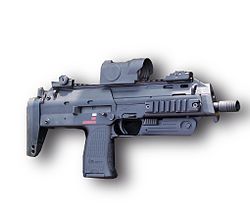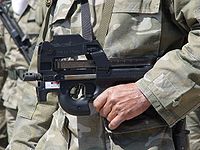- Personal defense weapon
-
 A Heckler & Koch MP7: the HK MP7 is part of Germany's IdZ modernization program and is now in use with police and military forces in Germany.
A Heckler & Koch MP7: the HK MP7 is part of Germany's IdZ modernization program and is now in use with police and military forces in Germany.
A personal defense weapon (PDW) is a compact semi-automatic or fully automatic firearm similar in most respects to a submachine gun, but firing an (often proprietary) armor-piercing rifle round, giving a PDW better range, accuracy and armor-penetrating capability than submachine guns, which fire pistol-caliber cartridges. The class of weapon as it exists today evolved as a hybrid between a submachine gun and a carbine, retaining the compact size and ammunition capacity of the former while adding the ammunition power, accuracy and penetration of the latter.
Contents
Origins
The modern PDW stems from weapons that were a combination of guns and knives, as they were specifically designed to be concealable weapons for the purpose of individual defense rather than a combat weapon. An early ancestor is the "dagger-pistol".[1] Many soldiers would benefit from lighter, more compact arms than the line infantry arm. In the 1800s and early 1900s, shorter versions of the infantry rifle were issued as 'carbines' for cavalry troops and gun crews, then dropped as infantry rifle designs were shortened such as in the Short Magazine Lee-Enfield rifle.
During the interwar period, the Argentine firm Hispano Argentina de Automotives SA (HAFDASA) introduced the C-2 machine pistol issued to armoured vehicle personnel. This weapon was basically a short variant of the C-4 submachine gun, fed from a 40/50 round casket box magazine depending on which calibre the weapon is chambered. Although the C-2 was an effective weapon, it did not see much service outside Argentina but predates designs such as the Škorpion vz. 61 and Ingram MAC-10.
Pistols generally were considered too limited in effectiveness for the role. In the First World War, the Mauser C96 and artillery versions of the Luger pistol were issued with attachable shoulder stock holsters and could partially meet this requirement. The World War II era M1 carbine can be considered a forerunner of modern personal defense weapons. It filled a similar role; it was not primarily intended for front line troops, but for support personnel such as drivers, engineers and medics to defend themselves in an emergency. Pistol-caliber submachine guns could fill the role, but were historically considered automatic weapons for front-line uses.
In 1986, United States Army Infantry School based at Fort Benning issued the reference document Smalls Arms Strategy 2000, which defines the APDW (Advanced Personal Defense Weapon). The earliest weapons marketed as PDWs were the Heckler & Koch MP5K-PDW and the GG-95 PDW.[1]
PDWs were developed during the late 1980s for non-combatant troops as compact automatic weapons that could defeat enemy body armor. Standard pistols and submachine guns chambered for pistol rounds had proven ineffective against armored soldiers and compact lightweight weapons capable of penetrating body armor were needed. In this role, they were supposed to be a more convenient alternative to the standard assault rifle, as their smaller size and lighter weight would be less of an encumbrance to a person whose primary function on the battlefield was not frontline fighting.
Ammunition
Typical PDWs use small-caliber, high-velocity pistol bullets similar to miniaturized rifle rounds, which are capable of penetrating soft body armor up to Level IIIa. PDWs are otherwise similar to submachine guns in most respects, and are often classified as such. Both types of guns tend to have a very high rate of fire which, when combined with the lower recoil of the smaller pistol-sized cartridges, increases the probability of multiple hits.
Applications
The PDW concept has not been widely successful, partly because PDWs are not significantly cheaper to manufacture than full size assault rifles. PDWs also usually use a special cartridge, such as the 5.7x28mm cartridge of the FN P90 or 4.6x30mm of the Heckler & Koch MP7, neither of which are compatible with existing pistols and rifles. A different take on the PDW concept is the Russian made PP-2000, which can fire the common 9x19mm Parabellum round or a special armor-piercing version to give it the same capabilities as other PDWs.
Though they have not become very popular for their intended application, personal defense weapons have been acquired by many special forces and law enforcement groups as direct replacements for submachine guns. FN's P90 personal defense weapon and PDW-caliber Five-seven pistol are used by military and police forces in over 40 countries throughout the world, such as Canada, Cyprus, France, Greece, India, Peru, Poland, Spain, and the United States.[2] The Heckler & Koch MP7 personal defense weapon is also used in a number of countries, including Austria, Germany, Ireland, Malaysia, and the United Kingdom.[3][4]
Like submachine guns, PDWs are small and light weapons, and their low recoil enables higher accuracy. Like assault rifles and carbines, PDWs can also penetrate body armor, while traditional pistol caliber submachine guns cannot. Assault rifles and carbines, by comparison, are generally heavier than either PDWs or submachine guns, have more severe muzzle blast and recoil, and are more likely to cause collateral damage due to overpenetration.
Modern personal defense weapons
- ČZW-438 – 4.38x30mm Libra
- Colt MARS – 5.56x30mm MARS
- FN P90 – 5.7x28mm
- Heckler & Koch MP7 – 4.6x30mm
- Knight's Armament Company PDW – 6x35mm KAC
- Magpul PDR – 5.56x45mm NATO
- PP-2000 – 9x19mm 7N21 +P+, 9x19mm 7N31 +P+
- QCW-05 – 5.8x21mm
- Saab Bofors Dynamics CBJ-MS – 6.5x25 CBJ-MS
- ST Kinetics CPW – 4.6x30mm, 5.7x28mm, 9x19mm[5]
- VBR-Belgium PDW – 7.92x24mm
- Modern Sub Machine Carbine – 5.56x30mm MINSAS
PDW-caliber pistols
- FN Five-seven – 5.7x28mm
- Heckler & Koch UCP – 4.6x30mm
- MP-443 Grach — 9x19mm 7N21
- QSZ-92 / QSW-06 – 5.8x21mm
- VBR-Belgium CQBW – 4.6x30mm, 5.7x28mm, 7.92x24mm
References
- ^ a b Fowler, Will; North, Anthony; Stronge, Charles; Sweeney, Patrick: The Complete World Encyclopedia of Guns, page 90. Anness Publishing Ltd, 2008.
- ^ Francotte, Auguste; Claude, Gaier; Robert, Karlshausen, eds (January 2008). Ars Mechanica - The Ultimate FN Book. Vottem: Herstal Group. ISBN 9782874158773.
- ^ http://www.bmi.gv.at/cms/BMI_EKO_Cobra/publikationen/files/LawOrder.pdf
- ^ Gourley, S.; Kemp, I (November 26, 2003). "The Duellists". Jane's Defence Weekly (ISSN: 02653818), Volume 40 Issue 21, pp 26-28.
- ^ St Kinetics CPW as PDW
Categories:- Firearms
Wikimedia Foundation. 2010.

